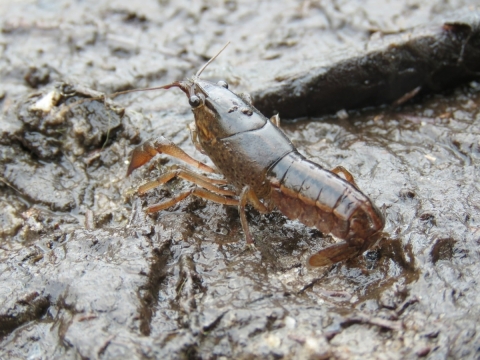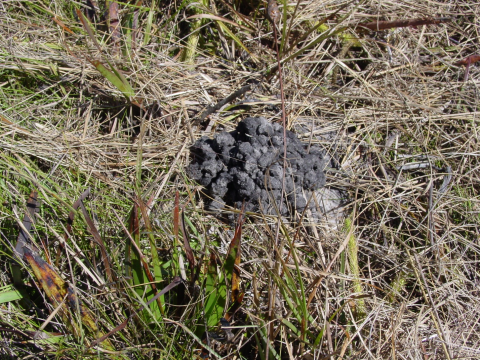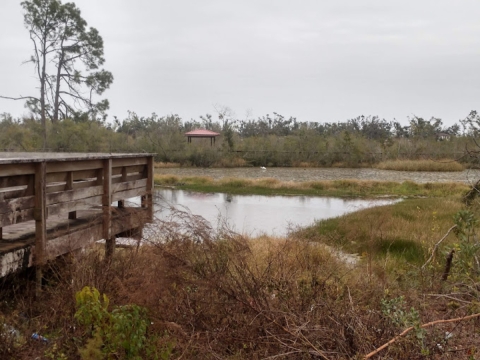Panama City crayfish: A Small but Mighty Critter
The Panama City crayfish (Procambarus econfinae) is endemic to Bay County, Florida, and requires wet flatwoods or prairie-marsh habitats with grassy vegetation, minimal tree cover, hydric soils, and shallow pools with fluctuating water levels. In the absence of surface waters, wet soil types support the species' need to burrow during the dry season and drought conditions. Undeveloped lands that historically supported pine flatwoods and wet prairie habitats can sustain the habitat needed by the crayfish to survive and reproduce.
Threats to the Panama City crayfish include habitat fragmentation, disrupted natural wetland hydrology, and loss due to development on lands with desired soil types. The overarching strategy for recovery of this species is to ensure the survival of viable populations throughout the species' historical range through coordinated land management activities with conservation partners.
Crayfish are important to the overall ecosystem for many reasons:
- Biodiversity: Crayfish contribute to the overall biodiversity of aquatic ecosystems, creating a more resilient and balanced environment.
- Food Source: They are a key food source for many animals, including fish, birds, mammals, and amphibians.
- Nutrient Cycling: Crayfish play a significant role in nutrient cycling by breaking down plant material and detritus. This decomposition process releases nutrients back into the ecosystem.
- Habitat Engineers: Crayfish burrowing activities help to aerate the soil and create habitats for other aquatic organisms. Their burrows provide shelter for smaller creatures and contribute to the structural diversity of aquatic habitat.
- Water Quality: By consuming organic debris and plant material, crayfish help to maintain water quality. They reduce the buildup of decaying matter, which can otherwise lead to decreased oxygen levels and poor water conditions.
- Indicator Species: Crayfish are sensitive to pollutants, such as heavy metals, pesticides, and other contaminants, making them good indicators of ecosystem health. Their population levels can reflect overall quality of the aquatic environment.
By understanding and preserving crayfish populations, we can help maintain the health and stability of larger ecosystems, ensuring their continued function and resilience.
City Public Works and U.S. Fish and Wildlife Service Form Partnership
The City of Panama City, Florida, and biologists Patricia Kelly, Samantha Hermann, and Katie Ayers from the Florida Ecological Services Program and Panama City Fish and Wildlife Conservation Office have teamed up to manage habitat and introduce additional individuals to support the recovery of the federally Threatened Panama City crayfish. A voluntary agreement through the Partners for Fish and Wildlife Program set the foundation for the partnership and allows for potential funding from the U.S. Fish and Wildlife Service to support coordinated habitat management.
Several City of Panama City public parks in Bay County are within the historic range of the crayfish and contain suitable habitat for the species to thrive. The parks are currently managed with mowing to maintain the grounds, which happens to be beneficial for maintaining crayfish habitat too! Future habitat restoration activities may include invasive species invasive species
An invasive species is any plant or animal that has spread or been introduced into a new area where they are, or could, cause harm to the environment, economy, or human, animal, or plant health. Their unwelcome presence can destroy ecosystems and cost millions of dollars.
Learn more about invasive species removal and installation of fencing to protect critical wetland areas in the parks.
This partnership between the City of Panama City and the U.S. Fish and Wildlife Service demonstrates great integrity and collaboration to recover this species. The U.S. Fish and Wildlife Service hopes to install educational signage at the parks and involve local schools in field days. Through this partnership, we aim to better inform the public about endangered species conservation and encourage community members to enjoy the city's park spaces!
Introducing Panama City crayfish to Their New Homes
Plans are underway to develop the best approach for augmenting juvenile Panama City crayfish at Harvey Dee Mathis Park and Joe Moody Harris Park. The donor populations used for augmentation will be determined based on habitat similarity, proximity, and current population estimates at the time of removal. We expect an expansion of our knowledge on the effectiveness of augmentation, where we can easily monitor the progress of the population. Data will be collected on genetics, population distribution, and habitat selection to better inform conservation decisions in the future.
Huge thanks to everyone involved in this project to support the crayfish! Stay tuned for more updates this Fall.








